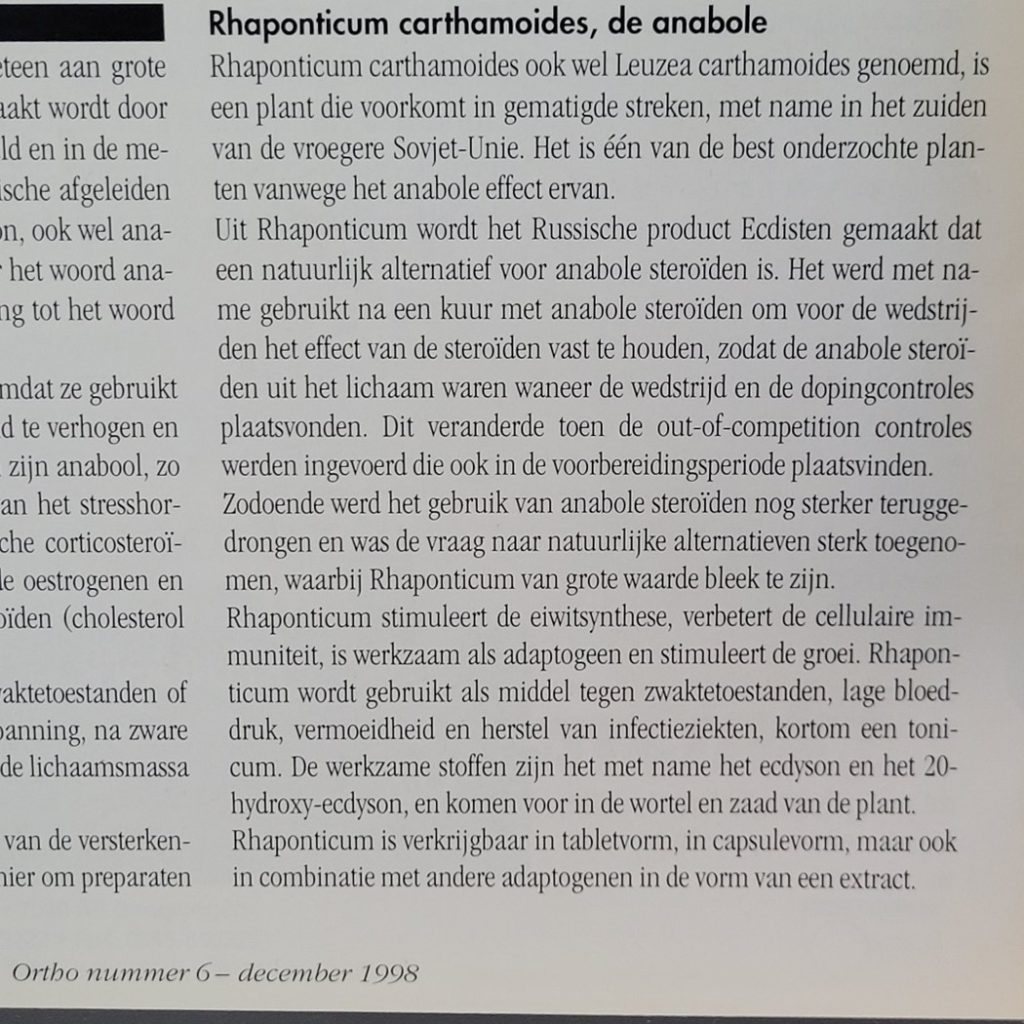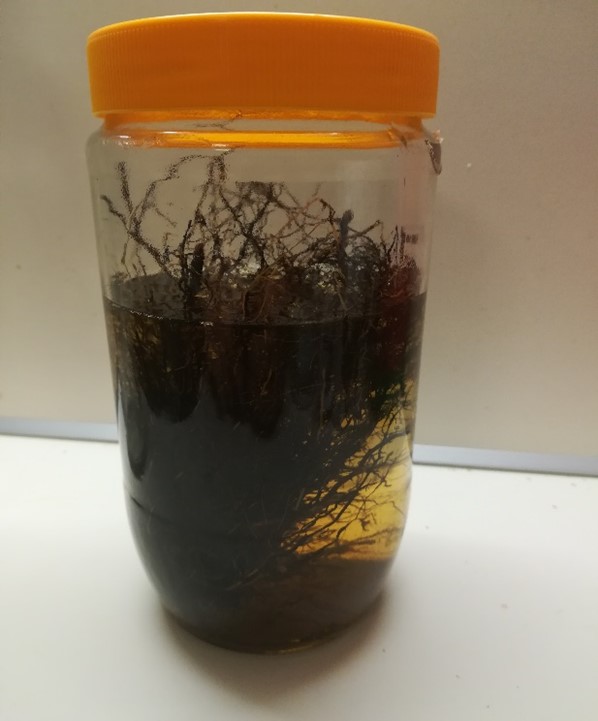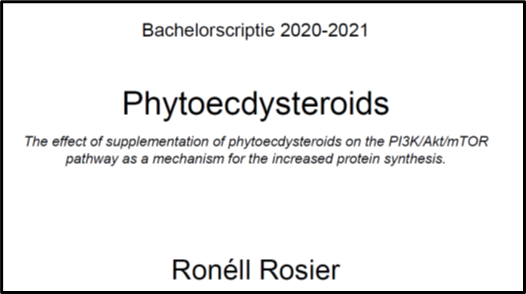I have written about this topic before, because I am a firm believer in the power of natural products tp maintain and/or improve health, and to enhance performance in daily life and in sport.
We have been using herbal extracts for the longest time: every time you drink coffee, tea, wine, beer, liquor, tonic, Cola, or fruit juices, you are doing this. Each plant contains a multitude of different chemical components and each component has a special function in the survival or reproduction of the plant. Since producing these different components is an energy consuming labour, we know these components are important for the plant, otherwise, why spend energy and resources manufacturing them?
A plant is a genius chemical manufacturer with millions of years of experience.
In the past, plants were reliable resources, not only for food, but also for the production of fragrances for well-being or medication for health. Many modern pharmaceutical products and drugs still are based on plants, starting with the street drugs like opium from the poppy, transformed into morphine and heroie. Aspirin from the willow bark, digitalis from the foxglove, cocaïne from the coca plant or think about cannabis products like CBD.
Many books have been written about this topic already, so I will limit myself to one particular plant that I know and have been using for a long time. One of my first articles in which I devoted a small chapter to this plant dates from December 1998.(1) The plant is called Rhaponticum carthamoides.

You might not have heard of it, but deep in the heart of Central Asia it is commonly used as a folk medicine and for many centuries. Other factors contributing to the fact that this plant is rather unknown, is that most of the research, articles and books were in Russian language at that time and the fact that is needs very specific and harsh circumstances to grow. Cultivating this plant so far has not been very successful. The origin of this plant is the Altay, the mountain ridge between Russia (Siberia), China and Kazakhstan. It needs very poor, rocky soil, very harsh winters and some altitude to grow.

Local people have been using this plant for a wide range of issues: weak young children, fragile older people, recovery from illness or infection, after surgery, in times of harsh conditions or stress. One of the main effects is that it contributes to anabolic processes and muscle growth. That is why it has been used in the former USSR to support training in elite athletes. And of course, older people suffering from sarcopenia (= loss of muscle tissue) can also use it to stay healthy for a longer time.

When my athlete and I visited Kazakhstan for competition and training, we started getting interested in this plant and bought it at the market. My athlete is a student of Human Movement Science, One of the topics she studied was the effects exercise for older people, to counteract sarcopenia and falling for the frail elderly. She wrote her bachelor-scription about the components of this plant and their effects on the human (muscle) cell and signalling pathways.

This motivated her to produce her own supplement based on Rhaponticum carthamoides of the very best quality available. The process wasn’t easy nor was it fast. The amount of paperwork and quality testing was tremendous, but she persisted and here it is: FLOURISH 580 (we have 580 muscles in our body).
I am proud having contributed a very small part to this and my athlete having the courage to start a company and her first nutritional supplement.
So about FLOURISH 580: it contains only Rhaponticum carthamoides extract and the package contains 60 capsules. Dosage is 1 capsule a day, preferably in the morning for 2 months. Elite athletes and individuals in stressful or demanding situations can take two capsules a day. Rhaponticum is an extremely safe product to use and has no known side effects. (2)

Rhaponticum is often regarded as a panacea, a cure for many different diseases.
The many different powerful components of Rhaponticum are the reason for its pleiotropic effects, meaning that these different components are able to affect many different signalling pathways within different cells.
FLOURISH 580 has a wide spectrum of potential usage, all well-documented.
One of the first monographs we found about this plant is from 1955. (3)

Some of the most important applications are:
– as an adaptogen, increasing the ability to handle stressful situations and controlling the stress response, preventing stress to become harmful to our body and mind (4)
– stimulator of the anabolic processes in the body: leading to increase in muscle mass or organ mass (anti-sarcopenia), while decreasing fat mass. Some researchers also indicate a shift from slow muscles to fast muscles. (5)
– immunostimulant: activating the immune system to improve our resistance to infections like viruses and bacteria (6)
– antioxidant: limiting the effects of damaging free radical molecules (7)
– researchers are even attempting to use these compounds for their application in cancer. (8,9).
Recently patents are filed since the pharmaceutical industry finally sees the true potential of this plant.
So, if you are interested in this product, find more information at : www.flrsh.nl
Or at Instagram: flrsh.nl
- Kraaijenhof, H. Kracht uit Kruiden part 2, Ortho, No.6, Dec. 1998, pg.260
- Petkov, V et al: Pharmacological Investigation on Rhaponticum carthamoides; Planta Medica. 50, 1984, pg. 205-209.
- Kushka, E; Aleksina, Y: Rhaponticum carthamoides (monograph), 1955.
- Todorova, V; Ivanov, K; Ivanolva, S: Comparison between the Biological Active Compounds in Plants with Adaptogenic Properties (Rhaponticum carthamoides, Lepidium meyenii, Eleutherococcus senticosus and Panax ginseng); Plants 2022, 11, 64.
- Todorov, I.N., Mitrokhin, Yu.I., Efremova, O.I., Sidorenko, L.I: Effect of extract from Rhaponticum carthamoides on RNA and protein biosynthesis in mice; Pharmaceutical Chemistry Journal Vol. 34, No. 9, 2000, pg. 479-481.
- Skopinska-Rozewska, E et al: Some immunotropic effects of Rhaponticum carthamoides; Central European Journal of Immunology 2010; 35(3), pg.138-141.
- Koleckar, V et al.: Evaluation of natural antioxidants of Leuzea carthamoides as a result of a screening study of 88 plant extracts from the European Asteraceae and Cichoriaceae; Journal of Enzyme Inhibition and Medicinal Chemistry, April 2008; 23(2): 218–224
- Skała, E et al: Rhaponticum carthamoides Transformed Root Extract Has Potent Anticancer Activity in Human Leukemia and Lung Adenocarcinoma Cell Lines; Oxidative Medicine and Cellular Longevity Volume 2018.
- Prosekov, A, Yu et al: Biotechnology of Cultivation of Rhaponticum Carthamoides (willd.) Suspension Cells: A Prospective Source of Antitumor Substances; Russian Agricultural Sciences, Vol. 48, 2022, pg. 197–202.

Ben 67 jaar .,Ik gebruik het nu 2 maanden had in de middag door mijn lichamelijke arbeid altijd na een uur of 2 enorme moeien benen .
sinds dat ik Flourish gebruik zijn mijn moeien benen verleden tijd en voel ik dat mijn benen sterker zijn geworden.
Ik ben voormalig topsporter, in 2009 gestopt maar nog steeds fit en zeer fanatiek. Ik ga richting de overgang (bijna 47 jr). Ik had wat meer last van mijn rechter trapezius en soms van mijn rechter lies. Ik doe aan vechtsport, voetbal , yoga en paardrijden. Daarnaast beweeg ik ook in mijn werk. Sinds ik Flourish gebruik voel ik me nog sterker, fitter, herstel ik sneller en ben ik scherper. Het lijkt ook dat ik droger ben geworden, terwijl ik echt niet minder eet. Naast Flourish drink ik ook dagelijks paddestoelen thee, eet ik biologisch en neem ik dagelijks bijenpollen en uiteraard vitamine d en magnesium. Ik denk dat de combinatie vast ook een rol speelt!
Ik blijf er voorlopig zeker mee doorgaan! Dank Henk